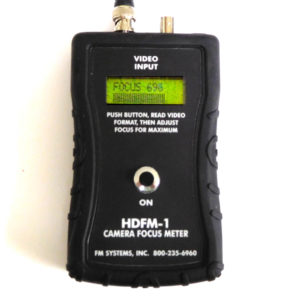HOW TO SHOOT A LICENSE PLATE WITH A CCTV CAMERA
By: Don McClatchie
FM SYSTEMS, INC.
When your customer asks you to set up a camera to shoot a license plate on a car, here are a few things you will want to know.
WHERE TO LOOK:
When setting up a camera to view a license plate, the framing is very important. You must frame the camera so that the plate will be in the camera’s view no matter where the plate is mounted on the car, or how the car is positioned in the roadway. The first trick is make sure you place the camera so that it can clearly see the numbers and letters on the license plate. Be sure to set the camera focus control for the sharpest focus. Make sure the plate is large enough in the scene to be identified. If you can do a good job of this, most installations will work very well during the daylight.
The camera works well during the day because the light from the sun is strong and defused, it comes from many sources by reflections off of all the objects in the immediate area.
THE PROBLEM:
Unfortunately an unaided camera does not do as good a job of reading license plates at night. They need some assistance to work well under dark circumstances. Even if the scene were well lit for observation by eye, a car presents special problems for a video camera.
Often area illumination will be placed immediately over the entrance and exit gates, a narrowing point just where you would like to see the license plate. Just as the car enters the gate area, a reflection from the overhead light bounces off the windshield and blinds the camera. The most common sources of camera blinding light are the headlights on the car. Any direct light source pointing into the camera lens at night will cause a camera blinding effect.
The camera blinding effect at the least will result in a loss of detail around the direct light source, like a blooming effect or halo. At its worst it can darken the screen so that you will only see the two headlights and everything else on the monitor will be black and unreadable.
THE CAUSE:
The blooming effect or halo type of loss is caused by the scattering of electrons on the CCD element inside the camera. This darkening effect is caused by the auto iris in the camera. When it sees the bright hot refection or headlights, the iris in the camera will close down the opening in the lens. An auto-iris takes the light that it sees and tries to determine how to set the opening in the lens for the best picture illumination. It can use a peek measure of the light level entering the lens, or when you engage the “Back Light” feature it will take an average of the light ignoring the hot spots. Unfortunately the back light feature in most cameras will not handle headlights or windshield flashes and only reduce the problem somewhat.
A CLUE:
A clue to the answer comes from the relatively good observations made during daylight. During the day most of a cameras received light comes from defused light and even if a car has its headlights on the camera hardly notices it, because the energy from the headlights are just a small portion of the light entering the lens.
HOW TO MAKE IT WORK:
To reduce the blinding effect of reflected light sources you can install a light source pointing directly at the car from the direction of the camera to where you wish to read the license plate. The light source must be bright enough to overwhelm the headlights on the car and stop the cameras auto iris from closing down due to the increase in direct light. To avoid blinding the driver of the car, you must use an infra red light source. People cannot see light in the infra red spectrum, but cameras can. In fact most CCTV cameras are very sensitive to the infra red light spectrum and will work quite well. Infra red light sources are available from the same manufacturers that you buy your cameras from.
Try a test the next time you have a license plate reading camera. Arrange the camera in the normal way, and see what happens when the cars lights are turned on. Notice the darkening of the picture on your monitor. Then point a regular bright white spot light at the car from the direction of the camera. Notice that the scene gets brighter but also the headlights have less of an effect on the iris of the camera and you can see more of the details of the car, with much less blinding effect.
The main point here it to overwhelm the direct light coming from the car with a source of light coming from the camera. If you do this, license plates can be seen easily even under the worst conditions.
If you need a meter to focus HD-TVI or HD-CVI cameras, here is our HDFM-1 Focus Meter. It will help you focus your cameras to the maximum and also report the format and line resolution.

HDFM-1


